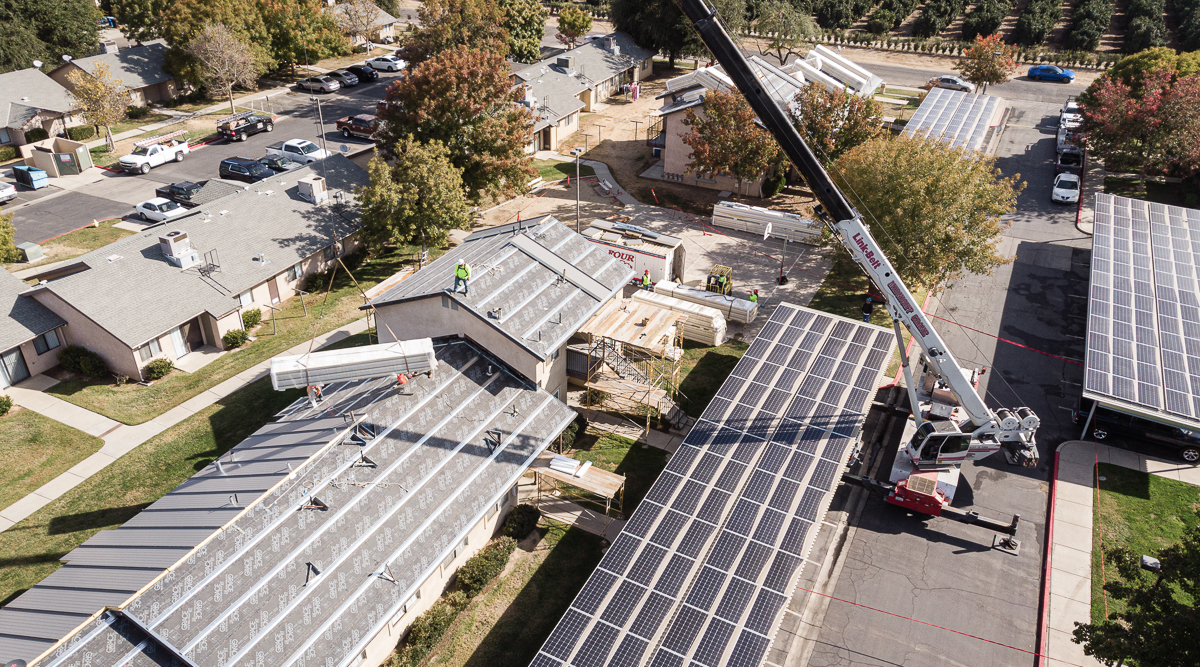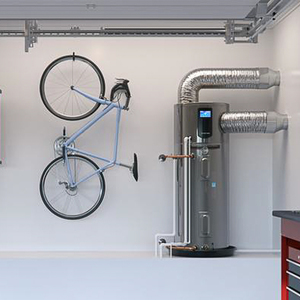
Homes across one of the most polluted and disadvantaged regions in California will be outfitted with state-of-the-art, electric-powered heating systems and appliances free of cost under a pilot program approved by the state Public Utilities Commission.
The 4-1 vote to fund the installation of high-efficiency electric heat pumps and other energy-efficient upgrades in up to 1,667 San Joaquin Valley homes is a first in California. The approximately $50 million project is expected to save participating households about $1,500 in energy costs each year, while also slashing local air pollution and greenhouse gas emissions.
The pilot is an important step in advancing the use of clean electric heating technologies and diminishing California’s dependence on fossil fuels. It will aid low-income homeowners and renters in 11 communities where outmoded home heating systems fueled by propane and wood contribute significantly to choking air pollution. If successful, these pilots will inform the rollout of a larger program to serve 160 additional communities across the San Joaquin Valley.
This initiative will also demonstrate to policymakers in other states and at the federal level how replacing residential appliances reliant on fossil fuels with highly efficient electric systems could reduce carbon pollution nationwide. According to a study by the Rocky Mountain Institute, using clean heating technologies in homes and businesses could cut U.S. carbon pollution by 10%.
Water and space heating among the upgrades
Under the program, homes heated by propane and wood in Allensworth, California City, Cantua Creek, Ducor, Fairmead, Le Grand, La Vina, Seville, and West Goshen will be outfitted with modern electric heaters and other appliances that will reduce pollution in their homes from burning fossil fuels. The improvements will include super-high efficiency heat-pump water heaters and space heaters, solar water heating, advanced weatherization measures, induction cooktops, smart thermostats, and high-efficiency electric dryers. All the appliances will include service guarantees to ensure a positive experience for residents.
In disadvantaged communities such as those in the San Joaquin Valley where average annual household income is about $31,000, the new technologies could make a difference not just in the air people breathe, but in the money in their wallets. Low-income families spend a higher percentage of their income on energy bills, often more than twice as much as middle-wage earners, and more than three times as much as high-income families. The program will also provide new jobs opportunities and training in the region.
The PUC decision also funds new natural gas service to 224 homes in California City, and may be extended to fund gas service (instead of electrification) in 210 of the 1,667 electric pilot homes if Southern California Gas Company can identify a funding source to cover the much higher cost of gas infrastructure, as compared to the cost of electrification, for two communities (Allensworth and Seville). Unfortunately, these new gas infrastructure investments could likely get stranded in the transition to a decarbonized future, potentially creating risk and higher costs for the utility and customers in the long run.
This pilot is part of a concerted effort by California state and local officials to cut carbon emissions by transitioning to clean energy. In September, Governor Jerry Brown signed into law Assembly Bill 3232 that sets the stage for reducing greenhouse gas emissions from California’s residential and commercial buildings by 40% by 2030 below 1990 levels, and Senate Bill 1477 that directs $50 million a year towards clean heating technologies and reducing emissions from new buildings.
Work remains to be done
The state has a long way to go. Homes and buildings are responsible for 25% of California’s greenhouse gas emissions, according to a Synapse Energy Economics report commissioned by the Natural Resources Defense Council (NRDC) and released in October. Over half of that pollution emanates from burning gas and propane. If a third of California’s buildings switched to clean electric space and water heating technology by 2030, heating emissions would fall by 7 million metric tons per year. That is equivalent to cutting the annual emissions from 1.5 million cars — or avoiding the pollution from nearly four 500-megawatt gas power plants running around the clock.
Against that backdrop, support in California is broad for exploring and testing innovative ways to reduce climate and air pollution generated by homes and buildings, according to a poll released in June. The survey found that 61% of Californians back incentives for using clean electricity to heat home and offices. Support for clean heating technologies is high across genders, ethnicities, and California regions. Policies that encourage clean heating technologies receive backing from 65% of respondents when the policies also reduce utility bills.
Innovative solutions are especially important amid two landmark climate reports underscoring the need for immediate and broad action to limit global warming and its impacts, one from the U.N. Intergovernmental Panel on Climate Change and the other from 13 U.S. government agencies in the 4th National Climate Assessment.
But while high-efficiency electric heat pumps and other clean technologies for space and water heating are available today, few contractors or customers are aware of them. The technology is relatively new, and while the pumps can deliver better long-term energy and utility bill savings, they cost more upfront than conventional heating equipment. Under the pilot, residents will not have to pay for the new appliances.
The pilot project aims to give the technologies greater visibility. If it reaps expected energy and cost savings, the Public Utilities Commission will consider extending the program to more than 160 other communities in the San Joaquin Valley.
Merrian Borgeson is a senior scientist in the climate & clean energy program at the Natural Resources Defense Council. This post originally appeared at the NRDC Expert Blog and is republished here with permission.
Weekly Newsletter
Get building science and energy efficiency advice, plus special offers, in your inbox.














5 Comments
Have more of a question since CA understands that housing is a resource. In trying to bring affordable energy efficient homes to market. What should we focus on energy efficiency or green? They go hand in hand but a cork floor vs. vinyl plank flooring is well..... More realistic for affordability? These kinds of questions.
User-7006798,
First of all, can you tell us your name? (I'm Martin.)
Here are links to two articles that address your question:
"Green Building for Beginners"
"Who Deserves the Prize for the Greenest Home in the U.S.?"
Martin,
Thanks the first article was start at the beginning and I agree completely. While my project is ambitious for my standards a few more energy efficient homes on the market is great. While everyone else may target well heeled clients my focus is on the mobile home. My mission is to sell as many energy efficient homes as possible and destroy Palm Harbor and every other mobile home manufacturer I can.
My challenge so far is getting the design people engineers and consultants to buy in to commoditize what we do. Everyone wants to do all this data and just right stuff that adds little value. Good for all of us and our 5 reports and a bunch of slapping ourselves on the back. Personally my attitude is great now go do it till you puke.
Thanks again,
Daryl
Interesting project, sounds like someone will be making money off low-income households but will the households actually benefit from a reduction in air pollution? The Central Valley has the worst air quality in the whole state and probably most of the US but will 1600 mini-splits and electric water heaters actually help improve air quality there, likely not enough to notice. The all-electric home is one way to reduce GHGs provided that they are powered by solar electric systems. Will it benefit low-income households by reducing their utility bills? Not at all, especially since the CPUC-approved time-of-use (TOU) program for all PG&E customers goes into effect by the end of 2019 and electric costs will greatly increase even for people on CARE (low-income) rates. So If an electric BTU costs 4 - 5 times what a natural gas BTU cost, and rates are going up these upgrades are likely to cost low-income customers more not save them $1,500, especially when the average cost for low-income households in the state is about $750 annually. Many low-income households in this area use evaporative coolers because they can't afford DX AC costs. These systems will be making people money according to this article. This will work only if a 3 - 4 kW solar electric system with a battery pack is also included with the new higher efficient electric appliances
Thomas,
Your questions are good ones, but your responses are rather cynical. This program alone won't solve air pollution problems in California, but every little bit helps. I don't think that the motivation for this program is for contractors to make money. And yes, I believe that the families that enroll in this program will (a) be more comfortable, and (b) have somewhat lower energy bills.
Log in or create an account to post a comment.
Sign up Log in